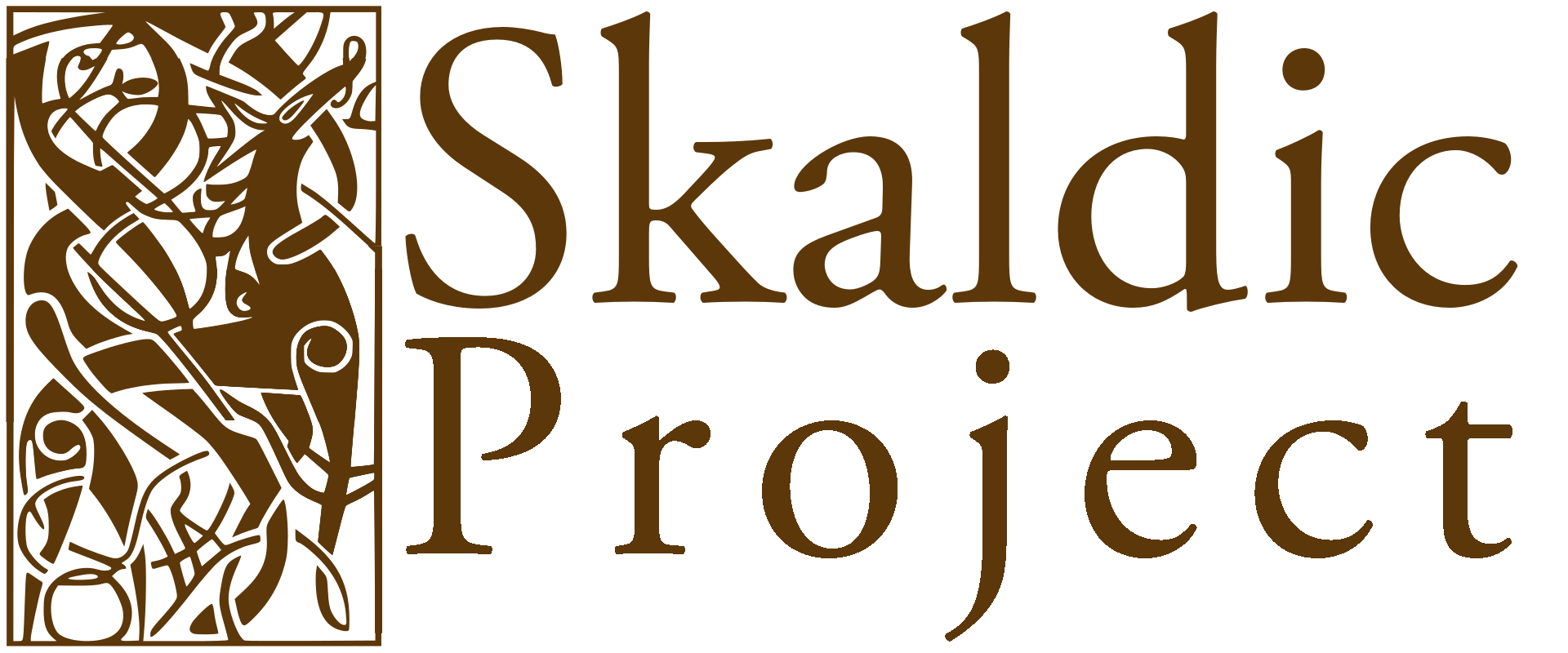Anon (TGT) 27III
Tarrin Wills (ed.) 2017, ‘Anonymous Lausavísur, Stanzas from the Third Grammatical Treatise 27’ in Kari Ellen Gade and Edith Marold (eds), Poetry from Treatises on Poetics. Skaldic Poetry of the Scandinavian Middle Ages 3. Turnhout: Brepols, p. 555.
Áðr djúphugaðr dræpi
dólga ramr með hamri
gegn á grœðis vagna
gagnsæll faðir Magna.
Áðr {djúphugaðr, ramr, gegn, gagnsæll faðir Magna} dræpi á {dólga {grœðis vagna}} með hamri.
Before {the deep-minded, mighty, reliable, victory-blessed father of Magni <god>} [= Þórr] struck at {the enemies {of the sea of wagons}} [LAND > GIANTS] with his hammer.
Mss: A(6v), W(107) (TGT)
Readings: [1] dræpi: corrected from ‘drę́gi’ A, drepi W
Editions: Skj AI, 182, Skj BI, 171, Skald I, 92; SnE 1818, 326, SnE 1848, 193, SnE 1848-87, II, 156-7, 421, III, 147, TGT 1884, 26, 100, 212, TGT 1927, 73, 104.
Context: This is the last of three examples (after Þul Sea-kings and Máni Lv 5) which Óláfr gives for the figure dialyton (‘dialiton’), the use of many nouns without a conjunction. The example is introduced as follows (TGT 1927, 73): En svipa heitir þat ef fleiri sannkenningar heyra einum hlut oklaust ‘But it is called “whip” if several sannkenningar refer to the same thing without [the conjunction] “and”’.
Notes: [All]: In the preceding paragraph, Óláfr equates dialyton with a native term klauf (‘cleft, cloven hoof, head of cattle’) which is the use of two sannkenningar or epithets without a conjunction (more properly asyndeton), exemplified by Máni Lv 5. In the present example, the figure is equated with another term, svipa (‘whip’), i.e. many epithets attached to the same noun without a conjunction. Neither the term klauf nor svipa are elsewhere attested with this particular grammatical sense. — [All]: This stanza is dated to the C10th by Finnur Jónsson (Skj), presumably on the basis of the pagan subject matter, but there is no other evidence to support such an early date. — [1-2] áðr djúphugaðr … dræpi dólga ‘before the deepminded … struck the enemies’: The opening of this stanza is identical with Þjóð Haustl 6/5. Although the subject of the narrative in Haustl 6 is Loki, not Þórr as here, this fragment has strong echoes of the helmingr in Haustl: there, Loki strikes a giant with a pole; here, Þórr strikes a giant with his hammer. The two helmingar contain the only examples in the corpus of a giant-kenning of the type ‘enemy of the land’ (dolgr vallar ‘enemy of the earth’ in Haustl 6/6).
References
- Bibliography
- TGT 1884 = Björn Magnússon Ólsen, ed. 1884. Den tredje og fjærde grammatiske afhandling i Snorres Edda tilligemed de grammatiske afhandlingers prolog og to andre tillæg. SUGNL 12. Copenhagen: Knudtzon.
- SnE 1848-87 = Snorri Sturluson. 1848-87. Edda Snorra Sturlusonar: Edda Snorronis Sturlaei. Ed. Jón Sigurðsson et al. 3 vols. Copenhagen: Legatum Arnamagnaeanum. Rpt. Osnabrück: Zeller, 1966.
- SnE 1848 = Sveinbjörn Egilsson, ed. 1848. Edda Snorra Sturlusonar, eða Gylfaginning, Skáldskaparmál og Háttatal. Reykjavík: Prentsmiðja landsins.
- Skald = Kock, Ernst Albin, ed. 1946-50. Den norsk-isländska skaldediktningen. 2 vols. Lund: Gleerup.
- TGT 1927 = Finnur Jónsson, ed. 1927b. Óláfr Þórðarson: Málhljóða- og málskrúðsrit. Grammatisk-retorisk afhandling. Det kgl. Danske Videnskabernes Selskab. Historisk-filologiske meddelelser 13, 2. Copenhagen: Høst.
- SnE 1818 = Rask, Rasmus Kristian, ed. 1818a. Snorra Edda ásamt Skáldu og þarmeð fylgjandi ritgjörðum. Stockholm: Elmen.
- Internal references
- Elena Gurevich 2017, ‘ Anonymous, Heiti for sea-kings’ in Kari Ellen Gade and Edith Marold (eds), Poetry from Treatises on Poetics. Skaldic Poetry of the Scandinavian Middle Ages 3. Turnhout: Brepols, p. 987. <https://skaldic.org/m.php?p=text&i=1045> (accessed 20 April 2024)
- Margaret Clunies Ross 2017, ‘ Þjóðólfr ór Hvini, Haustlǫng’ in Kari Ellen Gade and Edith Marold (eds), Poetry from Treatises on Poetics. Skaldic Poetry of the Scandinavian Middle Ages 3. Turnhout: Brepols, p. 431. <https://skaldic.org/m.php?p=text&i=1438> (accessed 20 April 2024)
- Kari Ellen Gade (ed.) 2017, ‘Máni, Lausavísa 5’ in Kari Ellen Gade and Edith Marold (eds), Poetry from Treatises on Poetics. Skaldic Poetry of the Scandinavian Middle Ages 3. Turnhout: Brepols, p. 290.
- Margaret Clunies Ross (ed.) 2017, ‘Þjóðólfr ór Hvini, Haustlǫng 6’ in Kari Ellen Gade and Edith Marold (eds), Poetry from Treatises on Poetics. Skaldic Poetry of the Scandinavian Middle Ages 3. Turnhout: Brepols, p. 440.
Stanza/chapter/text segment
Use the buttons at the top of the page to navigate between stanzas in a poem.
Information tab
- text: if the stanza has been published, the edited text of the stanza and translation are here; if it hasn't been published an old edition (usually Skj) is given for reference
- sources: a list of the manuscripts or inscriptions containing this stanza, with page and line references and links (eye button) to images where available, and transcription where available
- readings: a list of variant manuscript readings of words in the main text
- editions and texts: a list of editions of the stanza with links to the bibliography; and a list of prose works in which the stanza occurs, allowing you to navigate within the prose context
- notes and context: notes not linked to individual words are given here, along with the account of the prose context for the stanza, where relevant
Interactive tab
The text and translation are given here, with buttons to toggle whether the text is shown in the verse order or prose word order. Clicking on indiviudal words gives dictionary links, variant readings, kennings and notes, where relevant.
Full text tab
This is the text of the edition in a similar format to how the edition appears in the printed volumes.
Chapter/text segment
This view is also used for chapters and other text segments. Not all the headings shown are relevant to such sections.
